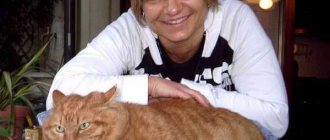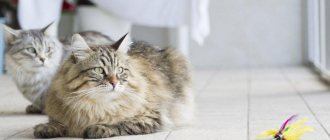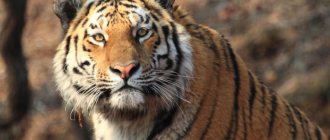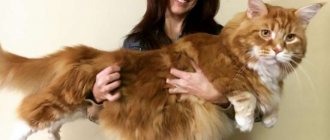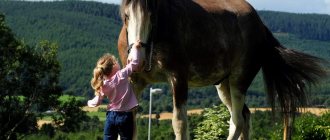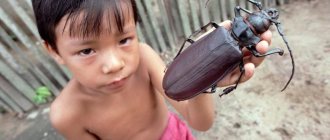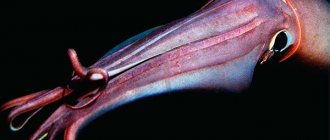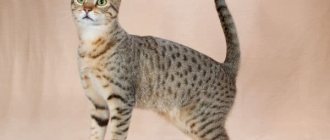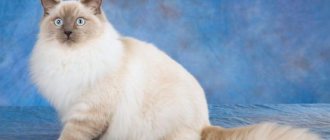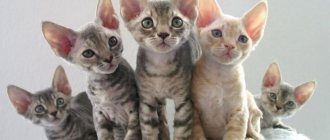The largest domestic cat in the world is the Savannah, its height can reach 0.6 m, and its weight is 15-16 kg, sometimes 20. Other large breeds weigh on average no more than 10 kg. In terms of habits and grace, they are in no way inferior to their brothers, but their size is amazing. These cats are very friendly and sociable, which quite makes up for the fact that they require somewhat more serious care than smaller breeds.
Watch a video about the largest cat breeds on our Youtube channel Mr. Cat:
Top 10 biggest cats
Among the representatives of the largest breeds of domestic cats there are long-legged, lean, short-haired beauties and shaggy hulks with a somewhat predatory appearance.
The giants of domesticated representatives of the cat world, whose weight reaches fifteen kilograms or even more, include individuals of only a few breeds, and their prices are sometimes off the charts. Pets weighing from 7 to 12 kg are not so rare, but they look no less impressive and respectable. It is worth saying that cats, invariably included in the ranking of the largest, are mainly distinguished by their physique - solid bones, powerful muscles, and not at all by how well they are fed by their adoring owners. Without exception, all mustachioed giants reach their prime only by 3-4 years, and it is at this age that their individual weight is established. The overwhelming majority of males are much larger than females. Depending on the breed and litter, the difference in weight between them varies and can range from three to five to six kilograms.
Tiger
In first place among large cats is the tiger, one of the representatives of the panther genus. Most tigers live in Asia and feed on ungulates. These predators prefer to hunt alone, in the morning or late afternoon, and they see in the dark six times better than a person.
Tiger
Some characteristics of a tiger:
- weight varies from 180 to 300 kg;
- life expectancy up to 15 years, in captivity 25 years;
- the largest of the subspecies, the Amur tiger, reaches a length of three and a half meters;
- the predator accelerates to 60 km/h.
The most common subspecies of tiger, the Bengal, consists of 3,000–4,500 individuals. Three of the nine species have already become extinct, the rest are endangered.
Savannah
Savannah, the largest domestic cat on the planet, is one of the rarest, most expensive, exotic and young breeds. Selection work on its breeding began in the 80s of the last century and took place in stages. In fact, the Savannah is a hybrid of a domestic cat and an African serval - a predatory mammal, a close relative of the lynx and caracal, but in its color this beauty is more reminiscent of a cheetah. Her homeland is the USA, or rather, one of the farms in the state of Pennsylvania, where, as a result of crossing a serval and a domestic Siamese cat, a female was born, who was named Savannah - it was she who became the ancestor of the new breed. Later, breeders included Bengal cats, Egyptian Mau, and Ocicats in the selection process. The breed standard was officially approved in 2001.
Savannah is a magnificent strong animal whose weight reaches 15 kg, and sometimes exceeds this figure. The length of the cat's body is about a meter, and the height at the withers is about half a meter. Distinctive features of her appearance are an elongated neck, a nobly set head, tall slender limbs, thick fur, and large ears.
Despite the fact that the Savannah has a wild and, one might even say, unkind look, it is not at all aggressive. This cat is quite sociable, friendly to children, devoted to its owner, understands commands perfectly, like a dog, and is ready to walk on a leash without whims. However, in urban conditions, the savannah experiences discomfort, as it needs an active lifestyle. She must be able to realize her instincts: climb to heights, hunt, jump, demonstrating the wonders of tightrope walking - from a standing position, this pet can easily “jump” 3.5 meters vertically. Savannahs are not at all afraid of water; on the contrary, they are not averse to swimming a fairly decent distance.
Not all savannahs are the same: their size and habits depend on the degree of kinship with their wild ancestor - the serval. The cats that are the least distant from the serval are those designated as an F1 hybrid. These are the heirs of the first generation of mating animals - wild and domestic. They are the largest, rarest and, accordingly, expensive. The higher the number after F, the less Serval blood the Savannah has. F7 hybrid animals, for example, are similar in build and size to a regular domestic cat. Savannah kittens can cost anywhere from $4,000 to $20,000.
In 2006, representatives announced the appearance of a new breed of cat - the Asher. These animals were the result of crossing a Bengal cat, an Asian leopard cat and a serval cat. Initially, the cost of a kitten in the nursery was 20 thousand dollars, but despite this, Ashera quickly gained popularity. It soon became clear, however, that the DNA of these felines is identical to that of the Savannah, so this breed is not recognized today as a separate breed. However, these exotic-looking cats remain in high demand, and their prices have dropped significantly.
Savannah (Asherah)
Puma
The puma is a small cat, although its size is not small at all, 1-1.8 meters in length. It lives in North and South America, hunts deer, and leads a solitary lifestyle.
Puma
Interesting Facts:
- in nature, pumas live up to 20 years;
- the main enemies of pumas are bears, jaguars and wolves;
- the cubs do not come out of hiding unless their mother calls them;
- the puma reaches 65 km/h on the plains, but quickly gets tired.
Pumas are constantly hunted, but due to their adaptability to different living conditions, their subspecies are not under threat of complete extermination.
Maine Coon
Second place in the list of the largest cats is occupied by Maine Coons. Giant cats of the Maine Coon breed became known in the middle of the 19th century, when they began to be shown at fairs held in the northeastern American state of Maine. Legends that Maine Coons appeared as a result of crossing domestic cats and wild animals, including raccoons and lynxes, are still popular. The Maine Coon supposedly inherited its distinctively colored tail from the raccoon, and its charming ear tufts from the lynx. These spectacular versions are beautiful, but from a genetic point of view they do not stand up to scrutiny. Dog handlers are confident that the breed formed independently, as a result of natural evolution, but is intraspecific.
Maine Coons reach maturity in their fourth year of life. At this age, their weight can be 12-15 kg. They have a large and long body, a powerful chest, well-developed muscles, thick, strong paws. In addition to their power, Maine Coons can also be proud of their luxurious thick coat. Another distinctive feature of the appearance of this animal is its incredibly fluffy tail, which the cat uses to wrap itself in the cold season.
Maine Coons have a wonderful character - soft and accommodating. They are intelligent, smart, friendly, but do not tolerate familiarity. These cats love to live in pairs. Male Maine Coons are excellent fathers, enthusiastically taking part in raising their offspring along with females.
The longest cat belongs to the Maine Coon breed. A male named Stu, a native of Nevada, is known for measuring 1.23 m from the tip of his nose to the tip of his tail.
Maine Coon
Leopard
Its muscular, elongated body, strong legs and excellent eyesight make the leopard an ideal killer. Chasing prey, the powerful flexible cat accelerates to 58 km/h and makes jumps 7 m long. With a body weight of up to 66 kg, it is capable of killing prey 3 times its weight. The hunter always lifts the desired trophy up a tree for the subsequent meal.
The size of the predator directly depends on the geographical features of the area. Thus, four-legged inhabitants of open spaces grow up to 75 cm, inhabitants of forests - up to 67 cm. Decorated with a spotted pattern, short, thick fur lies tightly to the body. The belly and inner side of the legs are light yellow, the rest of the body is golden brown. Individuals with a black color are called panthers.
Chausie
Large, stately and elegant Chausies are young cat breeds. They were developed in the USA in the 60s of the last century, and were registered only at the beginning of this century. The Chausie was created by crossing the Abyssinian domestic cat and the wild jungle cat, also known as the marsh lynx.
Chausies are athletically built, they have a long body, and the height at the withers can reach 40 cm, which puts them in third place in our ranking of the largest cats. The weight of an adult male reaches 14.5 kg. These amazing cats have a completely wild appearance. Their coloring, predatory look, and hunting habits make you wonder if you should be afraid of them. But upon closer acquaintance, it turns out that the chausie is the sweetest creature: affectionate, gentle, peaceful, loving to purr, and quite loudly.
From their predatory ancestors, these cats inherited a passion for hunting, a love of water and a desire to conquer heights. They love to stock up, often sneaking unattended food from the kitchen. They should be fed raw meat and fish, quail eggs; cereals are contraindicated for them.
Chausie is a very rare breed of cat because it is quite difficult to breed them. Chausies are most popular in their homeland - in the USA; there are several nurseries in Europe. In the post-Soviet space, chausie are considered a rarity. The cost of a kitten of this breed can reach $10,000.
Siberian and Neva masquerade cats
The Siberian cat is the pride of Russian breeders and the first domestic breed recognized by all international felinological organizations. The name of the breed, which began to be bred in the late 80s of the last century, is symbolic, since animals common throughout Russia, and not just Siberia, took part in the selection. The largest, strongest animals with heavy bones and thick, long hair were selected for breeding. The result turned out to be excellent: the Siberian cat looks like a real taiga inhabitant: hardy, powerful, big, harsh. The average weight of adult males is 10 kg, but 12-kg Siberians are not at all uncommon.
Siberian cats have a strong nervous system and high intelligence. They are calm, reasonable, patient with children, and attached to their owner like dogs. These cats are fearless and excellent hunters.
The Siberian cat rightfully takes fourth place in our ranking of big cats, and to it we will also add the Neva Masquerade cat, which is considered its subspecies. Breeders from the Kotofey club bred this magnificent breed under the guidance of felinologist Olga Mironova and presented it at her cat show in 1988. The Neva Masquerade cat owes its name to the Neva River, on which St. Petersburg stands, and the color of its face, similar to a carnival mask.
Today, breeding of Siberian cats is carried out in the USA, Canada, Great Britain, Germany, Spain, Italy, Finland and other countries. The number of nurseries located around the world is more than three hundred.
Siberian cat
Neva masquerade cat
Ragdoll and ragamuffin
The top five largest cats in the world are ragdolls, along with their charming subspecies - ragamuffins. Ragamuffin, which means “ragamuffin” in English, is the creation of the creative American breeder Anne Baker, also known as the founder of the Ragdoll breed. Actually, Ragamuffins are ragdolls crossed with mongrel cats. Their appearance is very reminiscent of ragdolls, but these delightful creatures have a richer palette of colors. Ragamuffins can be long-haired or short-haired.
Representatives of this breed have an elongated, strong, muscular body; by the age of four years, the age of full maturity, they can gain weight up to 10 kg. Ragamuffins are similar in character to ragdolls: they are just as gentle, affectionate, in need of the love and attention of their owner, and, despite their impressive size, completely defenseless against the aggression of other animals.
The breed was introduced in 1994, but numerous ill-wishers of Ann Baker for a long time prevented the official recognition of Ragamuffins. Only in 2003 these cats received a status separate from ragdolls and were recognized by international canine organizations.
Ragdoll
a lion
The lion is one of the "big five" animals and is therefore found mainly in Africa. The size of the animal and the male's moon make it very impressive, making it the king of the jungle. The lion is the only cat species that is highly social. Hunting often takes place in groups. Once the prey is caught, the hierarchy becomes clear. Males eat first, then females and young.
- INTERESTING:
15 films worth watching
Norwegian Forest Cat
Luxurious Norwegian forest cats are the pride of all of Scandinavia, where they are considered aboriginal animals. Presumably their ancient ancestors are long-haired representatives of the cat tribe brought to these harsh northern regions. As a result of natural selection and adaptation to the Scandinavian climate, they became the founders of a special population of cats - large, strong, distinguished by endurance and very thick hair. At the beginning of the last century, the Norwegian authorities provided official protection to native wild cats, obliging foresters and rangers in nature reserves to fight back against poachers who caught these beauties en masse and took them out of the country. In the 1930s, breeders began systematically breeding Norwegian forest cats to avoid extinction of the animals, while preserving their pristine beauty. The Norwegian Forest Cat breed was officially recognized only in 1977.
The Norwegian Forest Cat looks powerful yet elegant. It has a strong, elongated body, the hind limbs are noticeably longer than the front, which is more typical for a lynx than for a domestic cat. This proportion allows this animal to descend from a height head down in a spiral, like a squirrel, which is not typical for most pets. The weight of an adult male can reach 10 kg, but visually, thanks to his luxurious fur, he “pulls” a whole pound.
The Norwegian's character is as magnificent as his appearance. He is an excellent and loyal companion, very inquisitive, sociable, but not annoying. The cat is extremely friendly and is always ready to make friends with other pets.
In the second half of the last century, King Olav V of Norway gave the Norwegian Forest Cat the status of a national breed. In Western and Northern Europe, this charming animal has plenty of fans; in the USA they are not very popular, and in Russia there are only a few nurseries where you can buy a guaranteed purebred Norwegian Forest cat kitten. They operate in Moscow and St. Petersburg.
Norwegian Forest Cat
Snow Leopard
To date, the number of snow leopards is unknown. The snow leopard, which lives far from people, is the most poorly studied representative of the feline tribe. The muscular wild cat is found in the mountainous regions of Central Asia and Southern Siberia at an altitude of 1.5–5 thousand m above sea level. Short, thick paws equipped with wide pads are adapted for walking on loose snow, and the ability to make 8-meter jumps helps to overcome deep crevasses.
The four-legged inhabitant of mountain peaks resembles a leopard in posture and size. The height of the male reaches 65 cm, weight - 55 kg. Fluffy gray-beige fur reliably protects from cold and camouflages in snowy gorges. A distinctive feature of the exterior is a meter-long thick tail, which the snow leopard uses as a rudder when running and jumping.
British shorthair cat
The British Shorthair cat is one of the oldest and largest English breeds. The ancient ancestors of these animals are presumably cats, brought to Britain by Roman legionnaires before our era. Over the centuries, they have interbred not only with each other, but also with native wild cats. British Shorthair cats became known as a breed in 1871, when they were presented at the London Cat Show, after which they gained extreme popularity. However, at the beginning of the twentieth century, the fashion for these cats passed, and by the 50s their population had decreased significantly. To preserve the breed, breeders began crossing the few representatives of the British Shorthair with Persian cats, as a result of which today these cats look a little different than a century and a half ago.
The Briton is a large, but quite compact in his constitution strong man, who, thanks to his superbly sculpted muscles and unusual plush fur, looks even more powerful than he actually is. On average, adult cats weigh up to 9 kg, but some pets weigh up to 12 kg. This is usually due to the fact that representatives of this breed are prone to obesity because they become inactive as they age. By their nature, British Shorthair cats are calm and independent, they treat others selectively, and do not allow strangers to approach them at all.
There is an opinion that the illustrations for the book “Alice in Wonderland”, created by the English artist John Tenniel, depict a British shorthair cat. Today the Briton is the recognizable “face” of the Whiskas brand.
British shorthair cat
Pixiebob
The breed, known today as the pixie bob, was originally formed through the process of cross-breeding in natural conditions between a domestic cat and a bobcat, a wild lynx. Due to the fact that these animals have the same karyotype, their offspring turned out to be fertile. In the 80s of the last century, American felinologists, having caught three wild individuals in the forest, began breeding them, trying to preserve the original appearance of the animal. In 1998, the new breed received the right to participate in the championships of the world's largest felinological organization TICA.
Externally, the pixie bob resembles a small lynx with a short tail. He has a powerful body, strong paws, and a wild, slightly gloomy look. The weight of an adult pet is 7-9 kg. Despite its stern and menacing appearance, the pixie-bob is a fairly peaceful, calm creature. It is not aggressive, rarely releases its claws, and will not bite a person at full strength. These cats are similar to dogs in their behavior and devotion. Pixiebobs do not meow, but when they play with each other, they growl. Their purring is not like the songs of domestic cats - it is very loud and heavy. These animals do not welcome other pets, but they also do not enter into conflicts with their four-legged brethren - they simply maintain their distance.
Pixie bobs produce few offspring - there are usually 2-3 kittens in a litter. This rare breed is recognized as a national treasure of the United States. Official permission is required to take cats out of the country.
Pixiebob
Caracal
This cat is most common in Africa and Southwest Asia. This species grows up to 91 centimeters in length and is recognizable by the feathers on its ears, which is why it is sometimes called the desert lynx. However, it is related to the lynx. The caracal is active at night and mainly hunts rabbits, small monkeys and rodents.
Turkish van
The ancestors of the Turkish Van are aboriginal semi-long-haired cats, who from time immemorial lived in the area adjacent to Lake Van, located in Turkey. This breed was discovered in the modern world by British journalist Laura Lushington, a big cat lover. From her trips to this region of Turkey in the 50s of the last century, she several times brought charming kittens, with which the breeding of the Turkish Van cat breed in Europe began. Today, the Turkish Van is recognized by all leading felinological international organizations.
An adult Turkish Van cat can weigh up to 9 kg. His body is muscular, long, with a wide, powerful chest. These pets love water fun and swim well. They are very active, sociable, overly inquisitive and emotional. They have a well-developed hunting instinct. In childhood and adolescence, these cats can even show some aggressiveness, biting and scratching their owners. However, with age their character becomes softer.
In Turkey, aboriginal Van cats (they are called van kedisi here) are very revered, are one of the symbols of the country and are listed in the Red Book. They are credited with the gift of bringing happiness and good luck; these animals are even allowed to enter the mosque. It is possible to export Turkish Vans from the country only with official permission.
Turkish van
Kurilian Bobtail
The list of the largest cat breeds is replenished with another giant, since adult individuals can weigh at least 7 kilograms.
This breed of cats was once moved from the Kuril Islands to the mainland at the end of the last century.
The breed is distinguished by the original shape of its tail, which is quite short (only 8 cm maximum) and somewhat resembles a pom-pom. If a cat of this breed has a tail longer than 8 cm, then this is considered a fault of the individual, and if its length is only 12 cm, then the cat can be removed from the competition.
Kuril bobtails are not afraid of either moisture or frost, although they do not like to swim, but at the same time they are excellent at hunting fish.
The behavior of this breed of cat is somewhat reminiscent of the behavior of dogs, since they are very curious, are highly active and never refuse long walks and fun games, involving various toys, where they carry them in their owner’s teeth, like dogs.
Chartreuse
The Chartreuse, or Carthusian, as well as medieval cat, is considered a French breed. However, historians in the field of felinology are confident that the ancestors of the Chartreux are cats brought to France from the East during the Crusades. In the 16th century, they were described as stocky animals with an ash-gray color with a blue tint. Initially, these big cats lived at the main monastery of the Carthusian order of Grand Chartreuse, but over time they bred in other regions of the country. After the First World War, French breeders began systematic breeding of the breed, and in 1928, Chartreuse was already taking part in exhibitions. Today, nurseries for breeding Chartreuse are located mainly in France and the USA.
In their appearance, Chartreuse cats resemble British shorthair cats, but they have a different constitution and lack the pronounced plushness of the coat characteristic of the British. When looking at their dense, well-built, compact body and short limbs, it may seem that these pets are lightweight, however, when you pick up a Chartreuse in your arms, you will immediately understand how deceptive this impression is. Adult Chartreux have significant muscle mass and can weigh up to 7 kg. They are very balanced and measured, one might even say phlegmatic. They seem to enjoy observing rather than acting. Chartreux meows very rarely, and their voice is so quiet that it is like a whisper.
It is difficult to find purebred Chartreuse in Russia. Often, even in nurseries under the name “chartreuse” they sell shorthaired blue cats of the British breed, European shorthaired blue cats or hybrids of these breeds. You can purchase a guaranteed purebred kitten in clubs that are members of the international felinological organization FIFe.
Chartreuse
Features of large cats
For large individuals, it is preferable to live in their own home rather than in an apartment. If it is located outside the city, then it is impossible to imagine a better place to live. There will be enough space for walking with your pet, enough fresh air and impressions.
Curly cats - examples of names of popular breeds
The characteristics of giants include their docile nature: they get along well with other pets, do not pose a danger to children and do not require complex care or an exotic diet.
Important! There is an interesting place in Russia, located in the Irkutsk region. It is called Big Cats and is located on Lake Baikal. The name has nothing to do with animals - during the times of Tsarist Russia, this was the nickname for the shoes worn by convicts.
